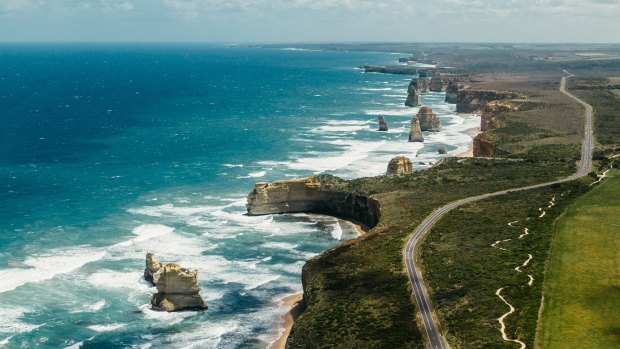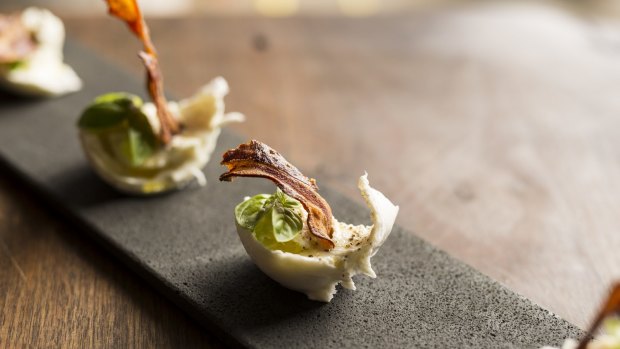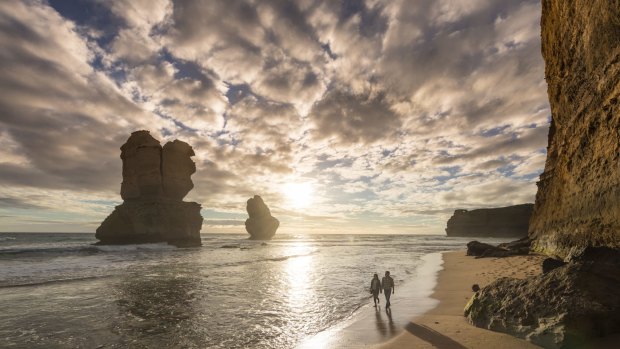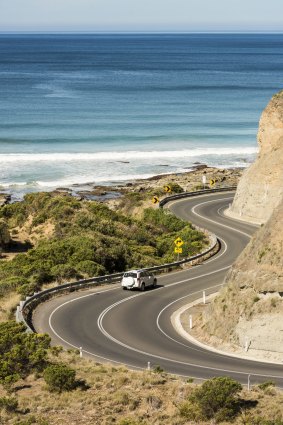Guide to driving Victoria's coast:The things you must see and do along the iconic Great Ocean Road
By Julietta Jameson

The Twelve Apostles are spectacular but there's much more to the Great Ocean Road than its most famous sight.Credit: Roberto Seba
It's a national tradition of sorts for Australian places to have greatness thrust upon them, in name at least. There's the Great Dividing Range, the Great Barrier Reef, the Great Artesian Basin and then there is the Great Ocean Road.
If any proof of the Great Ocean Road's greatness was needed, consider that it will soon be 100 years since construction commenced on what is arguably our most internationally famous drive. Today, the 240 kilometre-long road tracing Victoria's wild south coast is one of Australia's most popular touring routes, attracting 5.4 million visitors from all over the world in 2018 alone, 17 per cent more than the previous year.
Visitors come to experience its thrilling coast-tracing curves, spectacular views of Bass Strait and the Southern Ocean, its windswept beaches and golden sandy coves, its lush rainforest, dramatic sandstone cliffs and prolific wildlife. It is also, however, a lifeline for the 24,000 residents who live along it, connecting them to the regional cities of Geelong, Warrnambool and Melbourne beyond.

Basalt Winery, in Killarney, is the only winery along the Great Ocean Road.Credit: Robert Blackburn
On September 19, 1919, when work on the road began, it represented a lifeline of a different kind, providing work for more than 3000 returning Australian World War I soldiers who camped and worked in rugged terrain and in difficult weather conditions, creating the road using picks, shovels, wheelbarrows and hand-set explosives.
It was also something of a labour of love, built as a permanent memorial to their fallen compatriots – and still today is the largest war memorial in the world. Day trippers and those who rush through might miss how the Great Ocean Road wears that history as a badge of honour.
Taking a few days to meander the Great Ocean Road region – spanning from Torquay to near the South Australian border – rewards the traveller with a sense of the past, as well as immersion in a wonder-filled – you might even say great – present.

It pays to take your time exploring all the delights of the Great Ocean Road.Credit: Mark Watson
MELBOURNE TO ANGLESEA: 114 kilometres
The big-rig-bustle of the West Gate Freeway falls away as the road turns into the Geelong Bypass, bending through pasture transitioning into new housing estates. You could head to the famous surf of Torquay or follow the signs to Anglesea.
Heading for Anglesea, you soon hit the unspoiled hamlet of Freshwater Creek, which announces your arrival in the countryside. You might stop at Freshwater Creek Cakes for the passionfruit sponge and pass by the bluestone St David's Lutheran Church. If you choose to stop in and visit, the 1866 landmark rewards with its emerald stained glass, old cemetery and whispering pine hedge.

The Great Ocean Road twists and turns just outside the township of Lorne.Credit: Robert Blackburn
Picture-perfect, too, the little brown-doored boat sheds you will soon see dangling imaginary toes into the sepia water where Anglesea River meets the sea, an introduction to the town of the same name.
The sheds sit at the beginning of a boardwalk affording access to the 31.6-hectare Coogoorah Reserve, a wetland park and just a fraction of the hiking opportunities this village – and the region overall – offers.
All along the road, the quality providores and proprietors – and there are lots of them – are inspired by their glorious surrounds rather than reliant upon them, creating products, services and experiences that showcase their talents and the region in equal measure.
ANGLESEA TO LORNE: 28.5 kilometres
I have always loved leaving Anglesea township – which is not to say I don't love arriving there. It's just that from this point, the wildness of Bass Strait and the road's legendary proximity to it, reveals itself.
On this trip, my first day is a cold, changeable and quiet one in June. Most visitors head "down the Great Ocean Road", as local holiday-house owners say, during the warmer months. But winter has its special charms, one of which is lack of crowds.
It's worth pulling into one of Anglesea's surf beaches before going too far. I do this, entering a car park sprinkled with surfers doing that clever change-out-of-the-wetsuit-under-a-towel thing. The morning's weather has brought good surf and I watch a young woman ride a perfect wave from its height to tapered end, with the kind of form that makes me think she might be somebody special. I could watch for hours.
Soon, the six kilometres of Fairhaven Beach begin. Here, if you look up to the right, you may see what is dubbed "the most photographed holiday house in Australia". It's the Fairhaven house on a pole, an impossibly perched modernist cube joined to the land via a footbridge.
New, then old: also along this stretch, the Great Ocean Road Memorial Arch spans the bitumen. It's a rustic log construction with a beautiful bronze statue to the beach side depicting the workers who built the road and the spot also features some boards describing the history.
The Great Ocean Road remains a busy thoroughfare, warm months or cold. Signs along its entire length remind visitors to drive to the left – overseas motorists veering to the wrong side have created plenty of "horror crash" headlines. Nowhere is mindful and respectful travel more important, particularly given how reliant locals are on the road for access to the rest of the world.
LORNE TO APOLLO BAY: 47.3 kilometres
Well into the 19th century, the ocean was the only link to the outside world for the communities along this piece of coast. Rough tracks were eventually hewn across the dense bush of the Otway Ranges but the journeys were long and perilous.
An early iteration of the road was proposed in the 1880s, however, it wasn't until 1918 that surveying work began; hardy individuals forging ahead of the construction gangs to come, progressing three kilometres a month through the near-impenetrable landscape.
Though the length has expanded over the years, the original Great Ocean Road's footprint remains essentially as it was built, a wiggling carriageway which varies from hairpin bends (with names such as Devil's Elbow) to straight runs, and speed limits ranging through 50 to 100km/h. At least it's now dual carriageway – it began as single lane.
The Victorian state government is spending $53 million on fortifying and protecting the road, and works are ongoing, easing the most hazardous stretches, strengthening the cliff face and the road on its coastal side against erosion. Pothole fixing is virtually constant.
At the western end of Lorne's hilly residential enclave, Teddy's Lookout provides a remarkable bird's-eye view of a slice of the road at its most wiggly, following the snaking St George River estuary.
Bushland still sits sumptuously around the high-end and boho holiday homes of Lorne, a town where the historic pub, the Lorne Hotel, is a magnet for the summer-holidays' in-crowd.
APOLLO BAY TO PORT CAMPBELL: 98.2 kilometres
The scenery either side of Apollo Bay is dazzling, arguably some of the best along the road. Exhibit A: after a fortifying, locally sourced dinner at the legendary La Bimba (125 Great Ocean Road, Apollo Bay; labimba.com.au), I had arrived in the dark at the lyrically named Seafarers Getaway (6080 Great Ocean Road, Apollo Bay; seafarers.com.au).
In the morning, I opened the blinds and stepped out onto my private verandah to see a pasture with a dam at its centre surrounded by chilled-out alpacas, the indigo ocean behind them and, across the top of the scene, the perfect double rainbow. Rainbows are a magically common occurrence along the road in winter.
Reluctantly pushing on – after breakfast with the locals at relaxed Cafe 153 (153 Great Ocean Road, Apollo Bay; cafe153.com.au) – I meet Lizzie Corke, a local with a mission. As co-founder of the Conservation Ecology Centre (conservationecologycentre.org), alongside her partner Shayne Neal, Corke has been working on the conservation challenges in the region, including surveying and protecting quolls, and finding sustainable solutions for the koala population.
The couple also runs the beautiful, award-winning Great Ocean Ecolodge (Otway Lighthouse Road, Cape Otway; greatoceanroadecolodge.com) near the 1848 Cape Otway Lightstation, Australia's longest-serving lighthouse.
In a year's time when it opens, Corke and Neal will be custodians of Wildlife Wonders, an interactive walk-through experience co-imagined by Brian Massey, who designed Hobbiton in New Zealand.
As Corke walks me through the new 20-hectare site-in-progress, I can see it also owes much to Wellington's extraordinary wildlife reserve, Zealandia: predator-proof fencing, an enchanting, vista-affording piece of bush land, a remarkable vision.
That vision includes running the new facility as a social enterprise, designed to further support conservation endeavours.
"We looked at the ecolodge and what makes it so special and why people come back again and again," says Corke. "It's everything, but it's particularly the dusk walk; the chance to go into the bush with a conservationist and see wildlife in the wild and learn about it."
Leaving Corke, and heading towards Port Campbell, the drive takes a green turn, cutting a swathe through the dense forest of the Otway National Park. The drive is challenging: winding, undulating and enshrouded in low cloud. It is also a passage through a seemingly mystical landscape of ancient trees, ferns and waterfalls, the traditional lands of the Gadubanud people.
Reaching the notoriously inclement pinnacle of Lavers Hill in the rain, visibility is poor. But the road heads south towards the coast where the weather clears , and soon traverses flat farmland that butts onto the famous sandstone escarpments where the ravages of time have whittled the 12 Apostles and other dramatic formations.
PORT CAMPBELL TO PORT FAIRY: 89 kilometres
Chinese tourists alight from a bus and head down sleepy Port Campbell's main street. I head in another direction, down the hill to the beach and to Forage on the Foreshore (32 Cairns Street, Port Campbell; forageontheforeshore.com.au) for a bowl of tasty seafood ramen.
Just around the corner is Sow & Piglets Brewery in the Port Campbell Hostel (18 Tregea Street, Port Campbell; sowandpiglets.com), one of a number of excellent craft beer producers along the road.
When in this crayfishing port, I always visit History & Craft (42 Lord Street, Port Campbell), a modest volunteer-run museum that doubles as an outlet for the crocheting, knitting and sewing exploits of locals. I pick up a handmade scarf and a knee rug in my club colours for the footy, all for under $30 (cash only).
More spectacular stops await though – around Peterborough, just beyond Port Campbell, lie the Bay of Islands Coastal Park, The Grotto and London Bridge, all ravaged sandstone forms that teem with birdlife as the ocean continues its sculpting and rainbows proliferate on the horizon.
The Great Ocean Road technically finishes at Allansford – you'll see the sign announcing the completion, giving its official length as 244 kilometres. This is also where you'll find Cheese World. The name may be kitsch, but it's the popular factory shop for the famous Warrnambool Cheese & Butter company.
Cheese snacks secured, travelling further rewards mightily.
It would be a shame, for instance, not to explore the city of Warrnambool. Lovers of the 2015 movie Oddball will find the penguin colony central to the plot at Middle Island. Those who love vintage bric-a-brac and antiques should not miss the Fletcher Jones Market in the old eponymous clothing factory (61-77 Flaxman Street, Warrnambool; visitwarrnambool.com.au).
PORT FAIRY–TIMBOON–FORREST–BIRREGURRA: 168 kilometres
Twenty-eight kilometres from Warrnambool lies Port Fairy, along a road that is officially the Princes Highway but which flows seamlessly from the Great Ocean Road. Eight kilometres before Port Fairy is Killarney. The Irish name of the pretty village is a harbinger to the preserved cottage streetscapes to come and a strong clue as to the area's early European settlers.
Killarney is home to Basalt Wines (1131 Princes Highway, Killarney; basaltwines.com), the only winery on the Great Ocean Road and an award-winner at that. Shane Clancey's remarkable riesling and pinot noir benefit from organic treatment that includes a flock of Baby Doll Southdowns (sheep) roaming the vineyard to control weeds.
A newly expanded cellar-door restaurant serves a menu that reflects flavours of the local Indigenous people who resided in the area long before the whalers, sealers and agriculturalists came.
Paying further respect is a memorial on Bank Street in the centre of Port Fairy, dedicated to the thousands of people from the Dhauwurd Wurrung clans massacred during settler times. There is bloody history here, and elsewhere along the road.
Today, Port Fairy is a holiday town that holds a famous jazz festival each year (portfairyjazz.com.au). It's also home to 3500 permanent residents who enjoy some of Victoria's best pizza and excellent cocktails in the atmospheric Coffin Sally (33 Sackville Street, Port Fairy; coffinsally.com.au).
The pizza is worth the trip alone, as is a stay at Drift House (98 Gipps Street, Port Fairy; drifthouse.com.au), a remarkable achievement in hospitality, of a standard that would excel in the most competitive of luxury markets.
However, owners Colleen Guiney and John Watkinson state they offer "neither five-star opulence nor doily-wrapped Victoriana" within their two historical houses converted into six unique suites. And that individualist approach means a beautiful, architecturally award-winning, yet supremely comfortable stay.
I bunker down in suite six – one of two new offerings – which features an open fireplace and huge bathroom with big tub and rain shower. Breakfast, served in the sun-filled lounge (where a cosy sunken fire pit comes into its own of an evening), is a delicious testament to Watkinson's culinary skills.
As I check out, I confide to Guiney: I have had my best sleep in ages. It was so good, in fact, I get teary telling her about it. She takes it as the compliment it is meant to be. The couple have set up their inn hoping their guests will find emotional and spiritual connection. The number of regulars at breakfast indicates I'm not the only one regarding Drift House as my happy place.
Vowing to linger for days (and days) in Port Fairy next time, I head along undulating, cow-lined country roads, deep into the Otways, first stop: Timboon. Here, Tim Marwood established the Timboon Railway Shed Distillery (1 Bailey Street, Timboon; timboondistillery.com.au), an award-winning whisky distiller which he has since sold, and Timboon Fine Ice Cream (1A Barrett Street, Timboon; timboonfineicecream.com.au), which he continues to run.
He also established the Otway Harvest Trail (otwayharvesttrail.org.au), which includes the welcoming vibe of the Forrest Brewing Company (26 Grant Street, Forrest; forrestbrewing.com.au), my final foodie stop on this sojourn. It's buzzing with day trippers enjoying the beers and burgers, and I contemplate seeking accommodation for the night so I can truly settle in.
Not far from here is Birregurra, which Dan Hunter's world-famous Brae restaurant (4285 Mount Otway Road, Birreburra; braerestaurant.com) has put on the map, and which has risen to meet his reputation with excellent cafes, stays and weekend markets. Next time, I tell myself. I have been to Brae previously and often think of returning. The food, and the accommodation, are that good, once isn't enough.
One last stop before home and it's one of my favourites: the Moriac General Store (562 Cape Otway Road, Moriac), where there's an old-fashioned mixed lolly counter. Two dollars later, I've got enough musk sticks, freckles, bananas, red frogs and jelly babies to get me home.
As I head back down the Geelong Freeway, munching on that stash, my mind turns back to thrusting the label "great" upon things. It was Shakespeare who first noted: "Some are born great, some achieve greatness, and some have greatness thrust upon 'em."
The Great Ocean Road's birth was indeed great. It has achieved much, bringing billions to the Victorian economy. And as for greatness thrust upon it – in its 100 years of being, the love for it grows in a volume those founding fathers could surely never have envisaged. Great multiplied by three. May it continue to be for another 100 years and beyond.
Julietta Jameson travelled as a guest of Visit Victoria.
See visitvictoria.com; traveller.com.au/great-ocean-road, lornehistoricalsociety.org.au
THE GREAT OCEAN ROAD: A TIMELINE
1918
The Great Ocean Road Trust is established when, towards the end of World War I, William Calder, chairman of the Country Roads Board, asks the State War Council for funding to cover a scheme whereby returned soldiers would work on roads in sparsely populated areas in the Western District.
1919
On September 19, Harry Lawson, the Premier of Victoria, detonates an explosive near Lorne to mark the beginning of construction.
1932
The work of nearly 3000 returned soldiers is finally finished in November. During a weekend of festivities, Victoria's Lieutenant-Governor, Sir William Irvine, declares the road officially open.
1936
The user toll, paid at Eastern View, is abolished when the trust hands the road over to the state government.
1962
The Tourist Development Authority declares the route to be one of the world's great scenic roads. Sections are widened.
1983
The February Ash Wednesday bushfires rip through. Hundreds seek shelter on the beaches. Three people perish and nearly 800 buildings are destroyed in the Otway region. The peat in Coogoorah Reserve is alight and the Anglesea River is subsequently diverted to extinguish the fire.
2009
A large section of the Island Archway, the Great Ocean Road's iconic rock formation, collapses and crumbles into the sea. In July 2005, one of the large stacks that form the Twelve Apostles also collapsed.
2011
The Great Ocean Road is added to the Australian National Heritage List.
2015
The first Cadel Evans Great Ocean Road Race (named after the Australian Tour de France winner) for elite cyclists and the People's Ride, for the general public, is held along the road. The Christmas Day bushfire between Kennett River and Wye River destroys more than 100 homes and 2300 hectares of land.
2016
Heavy rainfall leads to more than 100 landslips along the road. There is significant damage to the surface leading to a full road closure for two weeks. A $53 million upgrade of the road is announced to reduce the risk of rockfalls and landslides.
2018
There are calls for more stringent rules regarding overseas drivers taking to Australian roads after a couple on a motorbike are severely injured when hit by a mini-bus travelling on the wrong side of the road.
2019
Construction begins on the Port Campbell Creek Pedestrian Bridge, as part of the Victorian state government's Shipwreck Coast Master Plan. The bridge will provide a connection between the Port Campbell township and the Discovery Trail, Port Campbell National Park.
FIVE OTHER GREAT AUSTRALIAN DRIVES
KOSCIUSKO ALPINE WAY, NSW
This 171-kilometre adventure cuts through the Snowy Mountains high country portrayed in Banjo Paterson's 1890 poem The Man from Snowy River. See visitnsw.com
BORANBUP DRIVE, WA
Less than four hours south-west of Perth, in the Leeuwin-Naturaliste National Park, the drive takes you through the heart of the Margaret River Region. See westernaustralia.com
EPICUREAN WAY, SOUTH AUSTRALIA
Traverse South Australia's four wine regions: McLaren Vale, Adelaide Hills, Barossa and Clare Valley along this route peppered in gourmet delights. See southaustralia.com
THE SCENIC RIM, QUEENSLAND
Stretching from Tamborine Mountain and the hamlet of Canungra, to Mount Barney, Boonah and Kalbar, this is the Gold Coast hinterland at its romantic and pretty best. See visitscenicrim.com.au
THE GREAT EASTERN DRIVE, TASMANIA
Meandering the coast of Tasmania from the Bay of Fires to Mariah Island and Buckland, this drive takes in some of Tasmania's most famous sites, including the Freycinet Peninsula and Wineglass Bay. See greateasterndrive.com.au
Sign up for the Traveller Deals newsletter
Get exclusive travel deals delivered straight to your inbox. Sign up now.